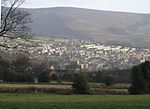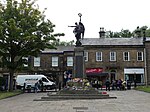Chunal
Derbyshire geography stubsHamlets in DerbyshireHigh Peak, Derbyshire

Chunal is a hamlet in Derbyshire, England. It is located on the A624 road, 1 mile south of Glossop. The philosopher Ludwig Wittgenstein conducted aeronautical research at Chunal during his time as an engineering research student at Manchester University (1908–1911). He flew kites into the upper atmosphere.There are three listed buildings in the locality, all designated at Grade II: White House, a farmhouse dated 1669; an 18th-century barn to the south of Shepley Farm; and Horseshoe Farmhouse and an adjacent barn. A public house, the Grouse Inn, closed in 2014/15 and is now a private house.
Excerpt from the Wikipedia article Chunal (License: CC BY-SA 3.0, Authors, Images).Chunal
High Peak
Geographical coordinates (GPS) Address Nearby Places Show on map
Geographical coordinates (GPS)
| Latitude | Longitude |
|---|---|
| N 53.423 ° | E -1.95 ° |
Address
SK13 6JY High Peak
England, United Kingdom
Open on Google Maps









